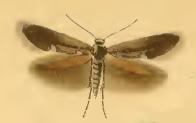
The chestnut ermine moth is an extinct species of moth in the subfamily Argyresthiinae. It was endemic to the United States. The species was only seen in two states, New Hampshire and Vermont. It became extinct due to chestnut blight obliterating its primary food source, the American chestnut.
Heliozela argyrozona is a moth of the family Heliozelidae. It was described in the genus Antispila by Edward Meyrick in 1918 and moved to the genus Heliozela by Erik J. van Nieukerken and Henk Geertsema in 2015. It is found in South Africa.

Heliozela is genus of moths of the family Heliozelidae, described by Gottlieb August Wilhelm Herrich-Schäffer in 1853.
Heliozela aesella is a moth of the family Heliozelidae. It was described by Vactor Tousey Chambers in 1877. It is found in the United States, including Illinois, Iowa, Kentucky, Massachusetts, Minnesota, New York, Ohio and Wisconsin and Quebec in Canada.
Heliozela anantia is a moth of the Heliozelidae family. It was described by Edward Meyrick in 1897. It is found in Tasmania.
Heliozela autogenes is a moth of the Heliozelidae family. It was described by Edward Meyrick in 1897. It is found in Queensland.
Heliozela crypsimetalla is a moth of the Heliozelidae family. It was described by Edward Meyrick in 1897. It is found in South Australia.
Heliozela eucarpa is a moth of the Heliozelidae family. It was described by Edward Meyrick in 1897. It is found in New South Wales.
Heliozela gracilis is a moth of the family Heliozelidae. It was described by Philipp Christoph Zeller in 1873. It is found in North America, including Texas.
Heliozela isochroa is a moth of the Heliozelidae family. It was described by Edward Meyrick in 1897. It is found in New South Wales.
Heliozela microphylla is a moth of the Heliozelidae family. It was described by Edward Meyrick in 1897. It is found in Western Australia.
Heliozela prodela is a moth of the Heliozelidae family. It was described by Edward Meyrick in 1897. It is found in New South Wales, Queensland and Tasmania.
Heliozela siderias is a moth of the Heliozelidae family. It was described by Edward Meyrick in 1897. It is found in South Australia.
Heliozela sobrinella is a moth of the Heliozelidae family. It was described by Deventer in 1904 as almost identical to Heliozela praeustella but a bit larger, with a wingspan of 6 mm. It is found on Java.
Heliozela subpurpurea is a moth of the Heliozelidae family. It was described by Edward Meyrick in 1934. It is found in Japan.
Heliozela angulata is a moth of the family Heliozelidae. It was described by Lee, Hirowatari and Kuroko in 2006 and is endemic to Japan (Honshu).
Heliozela biprominens is a moth of the family Heliozelidae. It was described by Lee, Hirowatari and Kuroko in 2006 and is endemic to Japan (Honshu).
Heliozela brevitalea is a moth of the family Heliozelidae. It was described by Lee, Hirowatari and Kuroko in 2006 and is endemic to Japan (Honshu).
Heliozela glabrata is a moth of the family Heliozelidae. It was described by Lee, Hirowatari and Kuroko in 2006. It is found in Japan (Honshu).
Heliozela limbata is a moth of the family Heliozelidae. It was described by Lee, Hirowatari and Kuroko in 2006 and is endemic to Japan.
